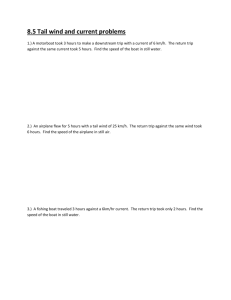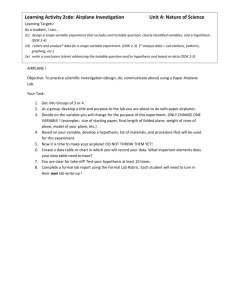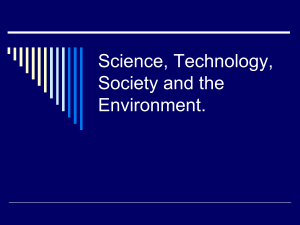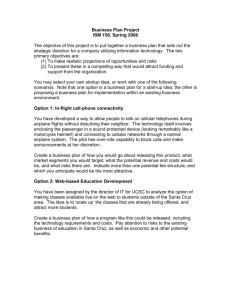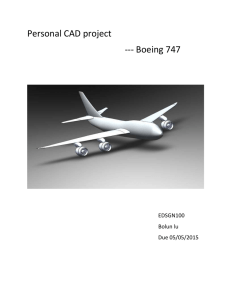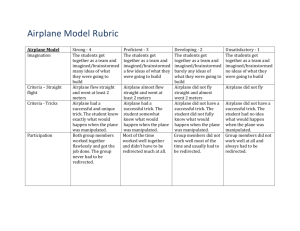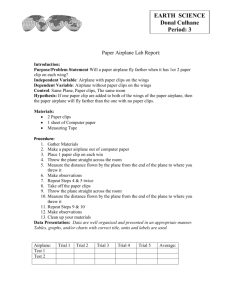advertisement
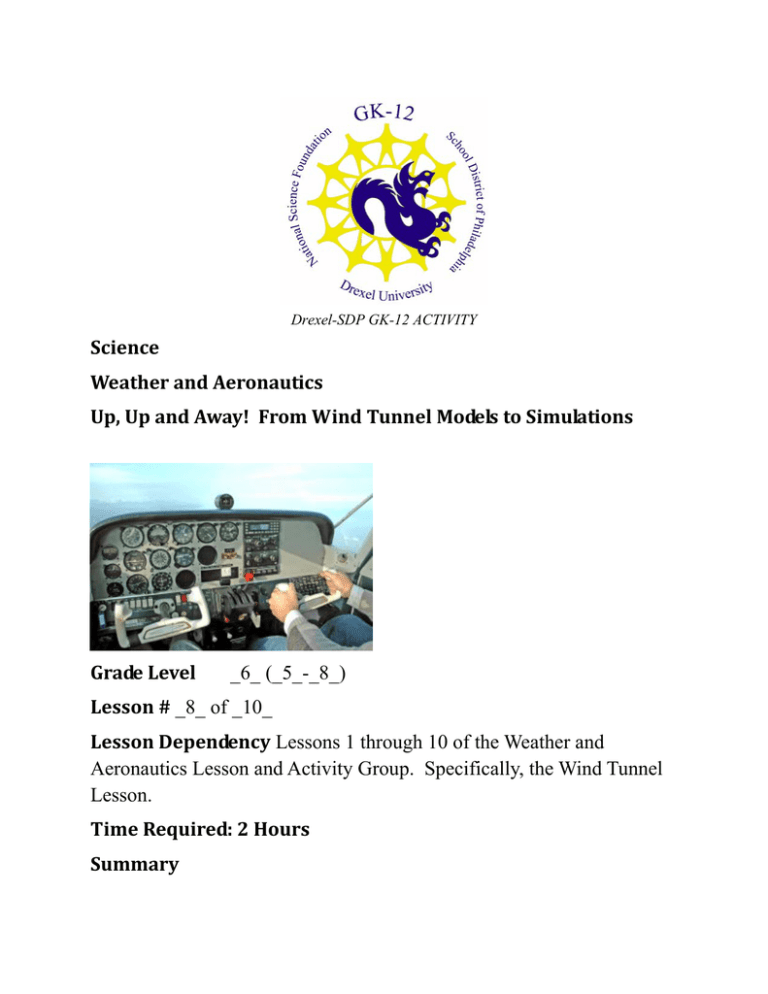
Drexel-SDP GK-12 ACTIVITY Science Weather and Aeronautics Up, Up and Away! From Wind Tunnel Models to Simulations Grade Level _6_ (_5_-_8_) Lesson # _8_ of _10_ Lesson Dependency Lessons 1 through 10 of the Weather and Aeronautics Lesson and Activity Group. Specifically, the Wind Tunnel Lesson. Time Required: 2 Hours Summary The goal is to motivate the basic problem of how to achieve controlled, powered flight, like the Wright Brothers did in 1903. There were many other players in this race besides just the Wright Brothers; people like Samuel Langley and Otto Lilianthal also worked unsuccessfully towards this goal. A little known fact from history is that the Wright Brothers also tried many times and failed to get their craft airborne. Their failures even resulted in broken bones and other injuries. Experimentation and discussion with other scientists led them to the conclusion that their mathematical model was flawed and in need of further testing. To accomplish this, and avoid further injury to themselves, they built a wind tunnel in which they could test their airplane wings very quickly in the lab, without having to drag their airplane to the beach for live testing. In this lesson, students will re‐create this testing environment and determine the configurations required to make an airplane pitch, yaw, and roll. Engineering Connection The aeronautics course is intended as a multi‐disciplinary course in physics, math and history of aviation. Navigation, forces of flight, principles of flight, history of flight, and environmental factors (including weather and landforms) are specifically investigated. The core curricular items are emphasized, and aviation is considered an underlying theme. The intent is to provide grounding to the curriculum components learned in a typical K‐12 school year. Aviation easily generates a lot of excitement among this age group, and as a result, measurable results are expected in these subjects. Keywords • Aeronautics • Weather • Aviation • Flight • Wind Tunnel Educational Standards • • • • • 3.1.7A Explain the parts of a simple system and their relationship to each other. 3.1.7B Describe the use of models as an application of scientific or technological concepts. 3.2.7A Explain and apply scientific and technological knowledge. 3.2.7C Identify and use the elements of scientific inquiry to solve problems. 3.4.7C Identify and explain the principles of force and motion. Learning Objectives After this lesson, students should be able to: • Identify the three axes of flight: pitch, yaw, and roll. • Construct a wind tunnel to test an airplane about these three axes of flight. • Determine the parts of the airplane that manipulate the airplane in each axis of flight. • Determine the configurations (movements) necessary to cause the airplane to move about each of the axes of flight. • Motivate the need for scientific models and lab tests to safely and quickly experiment with design hypotheses. • Discuss the history of the dawn of flight. Materials List Each group needs: • Model Airplane (a balsa kit model will do) To share with the entire class: • Computer with AVL simulator and template files Introduction / Motivation Part of the challenge in this project is that students will need to determine how to build a wind tunnel. There are a lot of subtle principles that come into play regarding smooth airflow through the wind tunnel. This may require some trial and error or some research up‐front. The amount of tweaking necessary can vary based on the age group; a functional wind tunnel for this activity can be achieved at a fairly basic level. In this activity, students will find it helpful to work in teams, and perform their research independently. One student might research the lives of the Wright Brothers (http://www.first‐ to‐fly.com/History/Wright%20Story/wright%20story.htm). Another student might investigate airflow over a wing via a computer simulation, and report back on the ease of using simulations before the actual construction (I have created such a simulation: http://gicl.cs.drexel.edu/wiki/Mongan#Athena_Vortex_Lattice_.28AVL.29). Students can use these simulations to see the relationship between flight configurations (like speed) and the resulting performance (turning radius). This can be investigated via open‐ended challenges like “make the airplane turn a corner of radius X without hitting the wall.” Still another student can investigate the wind tunnel (http://www.centennialofflight.gov/essay/Evolution_of_Technology/first_wind_tunnels/Tech34.htm). Students can make PowerPoint presentations to summarize their findings and teach each other. Then the building can begin in order to answer the questions at the beginning of the lesson. Vocabulary / Definitions Word Yaw Definition The side to side movement of the airplane produced by the vertical tail rudder. Pitch The up and down movement of the airplane produced by the horizontal tail elevator. Thrust The forward motion generated by the engine of the airplane. Lift The upward force on the airplane, generated by the wings, that counteracts the plane’s weight. Drag The opposite of thrust, just like weight is the opposite of lift. Roll The left to right tilting movement of the plane, produced by counteracting ailerons on the wings (one wing lifts up and one drops down). Model A scale design of a system, often for simulation purposes. Wind Tunnel A device that passes air over a structure like an airplane, for rapid testing and simulation purposes. Airfoil A structure that produces lift via Bernoulli’s Principle, by creating a pressure differential due to varying airspeed above and below the structure. Procedure Begin with a model of a modern airplane. If there are enough of them, pass them out to students; otherwise, replicate the model on the board. Ask the students if they can identify any of the parts of the airplane. Pair the students up and allow them to talk it out for a brief period, then come back as a class to make a combined list. See the AOPA PATH airplane parts diagram for a comprehensive list. Write the class’ list on the board, which should include the wings (ailerons), tail (rudder and elevator), and nose (propeller or jet engine). Now ask the students (still in pairs) to think about the different ways that the airplane can move. The students should determine that the airplane can move forward using engine thrust, up and down using wing lift, from side to side (this is called yaw) using the rudder, and from left to right using the ailerons on the wings. But how is this accomplished? By looking at the airplane, we have a pretty good hypothesis that the airplane moves because of the long, curved surfaces along the wings and tail, but how do they work? We will answer this question in this lesson, but to take a guess, think about the forces you feel on your hand when it is out the window slightly in your car. You might even practice by testing with a paper airplane. But would you really trust your own findings if you had just thrown a paper airplane a few times? This is hardly sound science and engineering – and you probably wouldn’t want to get on your own airplane knowing what little experimentation and theory went into your design. So there must be a better way to engineer a sound airplane. On the other hand, the concept of airplanes must have come from somewhere; how was the original airplane tested? Ask the class to guess who created the first airplane, and where and when it flew. The Wright Brothers are credited with this feat in 1904 at Kitty Hawk beach. Why do you think they selected a beach as their launching ground? They did so because the ground there is so soft, and they crashed often. Now, take a paper airplane and try to launch it. What happens? Some of you might have been successful, others may not have been. For the more successful students, try to modify the airplane so that it turns to the right (or left, or climbs, etc.). It is unlikely that anyone will be able to do this without grounding in the principles of lift and flight. Now imagine that you had actually been on board your paper airplane – how would it have felt to crash? The Wright Brothers suffered broken bones and other injuries during their testing, not to mention a damaged aircraft that they had to drag back to their bicycle shop, repair, troubleshoot, and try again. How can the Wright Brothers save themselves time, money, their bodies, and their aircraft? Today, computers are the way to go, but this is because they provide models of how the aircraft flies. Using a computer, we can simulate our aircraft and test its flight characteristics, and then build the aircraft to test. We wouldn’t be much more likely to succeed, because we still don’t know how to make our airplane turn, but at least we can guess without hurting ourselves or taking big risks. The Wright Brothers weren’t so lucky, though, and didn’t have computer technology available to them. There must be another way. Ask students to brainstorm ideas that don’t involve a computer. They may come up with some innovative ideas that may work, and they should be invited to try them. For this lesson, the suggested model is a wind tunnel. The wind tunnel allows students to create a model aircraft (or use a balsa wood kit) and test different configurations to determine what makes the airplane fly and move in controlled situations. After all, we wouldn’t want an airplane that we couldn’t positively control. Using index cards or other flexible materials, we can replicate the airplane’s control surfaces for pitch, roll, and yaw, and test various configurations of these surfaces until the airplane climbs, descends, rolls left and right, and yaws left and right when we want it to. The Wright Brothers’ wind tunnel was a bit more elaborate and used the actual airplane model as a test, but this will do for demonstration purposes. Like the computer model, this will allow us (and the Wright Brothers) to test their model quickly and safely, allowing for multiple hypotheses to be tested in one day. Students should keep a log indicating their guesses as they make them, record what actually happened, and note any differences. See the table below for an example. Aircraft Movement My Hypothesis What Actually Happened Why Was It Different? Pitch I think pitch is controlled by the wings because that is what makes the airplane fly. The cards should be bent upwards. The airplane sank but did not pitch either upward or downward. Perhaps the tail surface controls pitch even though the wings supply lift. So they must be separate. I will try that next. Yaw Roll Once the correct configurations are determined, we can see why the airplane is controllable under these circumstances. It is indeed similar to sticking one’s hand out the window and moving it up and down. To make the airplane pitch up, we in fact make the tail pitch downward by moving its flipper upward. By symmetry, this makes the nose pitch upward, and the airplane climbs if thrust is provided from the engine. Students can also investigate how airplanes produce lift by experimenting with Bernoulli’s Principle. Advanced students might take this on instead of the airplane configurations experiment if they demonstrate early mastery of the concept, and then demonstrate the principle to the rest of the class. To demonstrate Bernoulli’s Principle, take two ping pong balls and blow between them, guessing what will happen. To everyone’s surprise, the balls bounce together rather than fly apart! This is because of an air pressure differential between the ping pong balls. Things like to move from high pressure to low pressure, so the balls will come together. If we can create a pressure differential such that low pressure exists above the wing, the airplane will try to climb. If the amount of that climb is greater than the aircraft’s weight, it will “win the tug of war game” and actually lift off of the ground! To do this, think about how the ping pong balls came together. The lower pressure was created by blowing fast air between the balls. So faster air (like water through a pinched garden hose) exerts less pressure on the surfaces around it. So we must make the air above the plane go faster in order to create lower pressure. To do this, we can curve an airplane wing into an airfoil shape, which is essentially a half‐teardrop with the longer side on top. Air on the longer side will have to travel faster since it covers more distance in the same amount of time. More speed equals less pressure, and we have lift! Shape a piece of paper into an airfoil and blow into it – the paper will tend upwards! All of this is great, but it still doesn’t give us a working airplane. That is, how do we know how big to make our wings and tail? Bigger wings might mean more lift (some groups may have done this with their airplane models), but this also means more weight! Airplanes evolved over the last hundred years through experimentation, but with computers we can use a simulation as we discussed earlier. The software tool AVL (Athena Vortex Lattice) is an industrial‐strength wind tunnel simulation tool from MIT Labs. But if we start with an airplane template (see AVL Figure below) and modify the size of the wings, tail, etc., we can see what kind of performance we can get. For example, if the airplane can’t stay level while turning, we know that the airplane won’t work. Figure 1 ‐ Sample AVL Plane template with a simple body and control surfaces to be manipulated as part of the challenge. Your challenge is to use what you have learned about airplane control surfaces to design an airplane simulation model (using the template) that can turn an 8 foot corner without descending. If your airplane does descend, is it possible to fix the problem? How does an airplane overcome descending? By climbing! And now you know how to make an airplane pitch up, so you can do this. But the size of your tail will determine to what extent your plane can pitch up, so the plane in the simulation may descend even with full up tail deflection. This calls for a change in the model. Keep logging your guesses, results, and observations in your log table and see if you can make the airplane turn the corner within 8 feet and without descending. When you figure it out, we’ll take a video of your simulation and put it online with a description of your log and what you have learned. Results of the challenge can be seen in the form of a video that shows the plane in level flight, turning, etc., and via a graph as shown in the following example. Figure 2 ‐ Graph showing the amount of elevator and rudder needed to stay in the turn. The rudder value is negative (‐13.1914), it is actually the case that this airplane needs to be held forward to stay level; the wings are producing excess lift (success). Owner Drexel University GK‐12 Program Contributors William M. Mongan Copyright Copyright 2007 Drexel University GK12 Program. Reproduction permission is granted for non‐profit educational use Version: Mar 2007
